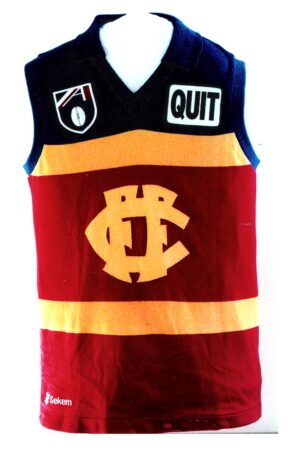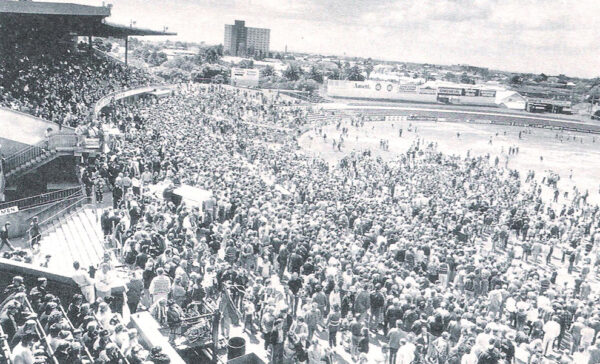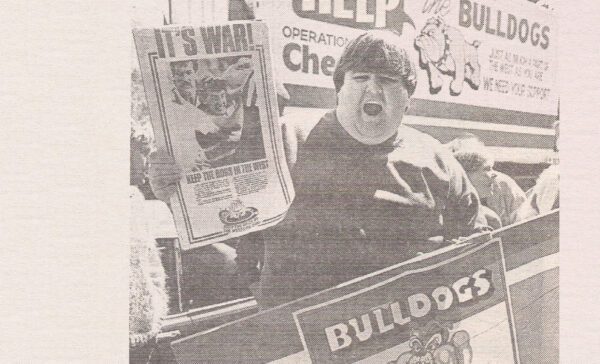Imagine how empty a footy season would feel without the Doggies playing for the west. The club almost ended 35 years ago but for a gutsy working class performance during 1989’s campaign to save Footscray Football Club (FFC). In fact, there’d be no historic ‘Fightback’ had not a Bulldog’s administrator rushed from the beers and back slapping of 89’s Best and Fairest to raise the alarm.
Terry Wallace had been announced top player, and the glitzy celebration was drawing to a close when a club director let it slip: the FFC board were about to ratify the Victorian Football League’s (VFL) secret strategy — a merger of clubs, Fitzroy and Footscray.
“This isn’t going to happen,” insisted a horrified Bulldogs’ CEO Dennis Galimberti, who freed himself from the pleading office-bearer trying to prevent him from storming out to blow the whistle on the VFL’s covert plan.
Back at his office, with precious minutes to spare before media deadlines closed, Dennis frantically briefed journalists. Next morning, after news of a terminal Bulldogs broke, the west was ablaze.
There may be no better chapter in modern history to shed light on the catch cry ‘Spirit of the West’ than the story of a ragtag mob of battlers triumphing over football’s establishment in ‘89’s David versus Goliath footy wrangle.
To be fair, the VFL’s strategy had merit. Creation of a national game demanded a rationalisation of Melbourne teams, and in the late eighties, the FFC was a poor imitation of a functioning club.
The Bulldogs’ 13th place on the league ladder confirmed concerns about the team’s competitiveness. But even bigger troubles lay off-field. Facilities at the Western Oval (renamed Whitten Oval in 1995) desperately needed renovation. And in a dying manufacturing centre where unemployment was running at forty percent, only six thousand or so fans had taken out a membership. Corporate sponsors were also hard to find.
FFC’s books painted the whole depressing picture: after recording an annual loss around $750,000, total loans were an estimated $1.5 million, a massive figure at a time when a modest home could be nabbed for $150,000. What’s more, continuing to operate conceivably ran foul of strict insolvency laws; something the VFL had impressed on the Bulldogs’ board.
Locals picked up their copy of ‘The Sun’ on October 4 to read in bold letters — ‘DEATH OF THE BULLDOGS’. Could this really be the end of a club founded in 1877? People were angry, others disbelieving … some dabbed tears from their eyes.
Scenes at the Western Oval were chaotic. People wandered around the ground. Memorabilia was taken from walls. Supporters took turns with a megaphone informally addressing an aimless crowd. It was a rudderless moment.
A group of Bulldogs’ loyalists formed the Save the Dogs committee, led by an ambitious legal talent, Peter Gordon. This group was the driving force behind the ‘Fightback’.
As it turned out, the VFL’s plans were well advanced: a logo had been developed, along with a moniker for the new club — the ‘Fitzroy Bulldogs’. The latest edition of Melways Maps had even been changed to show the merger team playing out of Princes Park, Carlton.

However, the VFL had fumbled the ball. A procedural slip opened the door to a legal challenge, arguing the merger was invalid without first consulting the Bulldogs’ membership. It was worth a try. All that was needed was an aggrieved member willing to risk financial ruin by taking the VFL to the Supreme Court.
‘I don’t give a stuff; I’ll go for the club!’ Irene Chatfield is remembered as saying as she barged into a huddle at the social club discussing how to find a willing member. Here stood their candidate, a working class heroine, who spoke with battle-ready gravitas.
At the hearing, an army of red, white and blue filled a courtroom to witness an injunction be granted. The reprieve gave supporters just 19 days to raise enough funds to clear the Bulldogs’ debt. It was a glimmer of hope. Yet, there remained a financial mountain to climb, which a VFL legal representative happily pointed out, telling the Bulldogs’ team, “I’ve just given you enough rope to hang yourself.”
The comment merely exposed another fumble — underestimating the dog in the fight. This was hardly the working west’s first battle with institutional power. Whether defying bosses by striking, protesting corporate malpractice or advocating for a decent slice of the public purse, courage and resolve were not lacking in the collective DNA.
“It was a tribal instinct; they knew they had to fight for what they believed in … they weren’t prepared to let that go for anyone,” says Dennis Galimberti.
Undoubtedly, class-based, east/west enmity fuelled the emotional flame. Best evidenced in the targeting of Ross Oakley, the smartly dressed VFL CEO considered silver-tail villain numero uno, with a uniquely working west bumper sticker that read ‘Up yours Oakley’.
But, this was a war to be won by the rattling of collection tins. In the end, the Bulldogs’ future hung on successful mustering of troops at a grassroots rally at the Western Oval.
By 10am on an October Sunday, ten thousand-strong had gathered, more than the number attending the last home game. Among them were players the VFL had warned away. And coach Terry Wheeler, who had driven through the night from a holiday to attend.


Around midday, almost half a million dollars had been collected, enough to believe the financial target was within reach. However, to secure victory, more cash was needed.
A red, white and blue army hit the streets and knocked on doors. Disadvantaged, who could ill afford to, gave what amounted to their groceries budget. Seniors handed over pension cheques. A disabled woman on crutches insisted on helping and headed out with a collection tin strapped around her neck.
Within weeks, the required amount was raised, and the VFL was forced to relent. The FFC was back in business, later attracting a corporate sponsor in a groundbreaking deal.
Best of all, players in a red, white and blue guernsey would be seen running through a banner onto the field again, rewarding a deserving community on the salty side of the Yarra in 2016 with a premiership.
For more information on 1989’s ‘Fightback’ visit the Western Bulldogs website.

